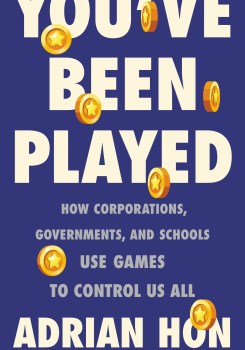How You’re Getting Played By Gamification
A video game designer takes a hard look at how gamification has spread from video games to many aspects of our daily lives.
The following is an excerpt from You’ve Been Played: How Corporations, Governments, and Schools Use Games to Control Us All by Adrian Hon.
Disclaimer: When you purchase products through the Bookshop.org link on this page, Science Friday may earn a small commission which helps support our journalism.

You've Been Played: How Corporations, Governments, And Schools Use Games To Control Us All
A warehouse worker picks a book from a tray and her virtual dragon speeds up on a screen beside her. If she works faster and longer than her colleagues, she’ll win the race and get an award. It’s a distraction from the tedium, but it’s hardly fun.
Not far away, an exhausted Uber driver is about to sign off when a new Quest pops up on his app: if he completes another three trips, he’ll get a $6 bonus. He’s barely making enough to cover the payments on his car, so he sighs—and accepts.
At home, his partner obsessively “researches” the dangerous QAnon conspiracy theory on obscure forums, videos, and blogs. It’s not as relaxing as watching TV, but uncovering clues and drawing connections makes him feel like he’s playing an exclusive game.
Next door, a retiree buys a subscription to a brain training game. It tells her that if she plays its “scientific” minigames every day, she’ll get smarter and avoid dementia. The game doesn’t tell her that going for a walk outside would be just as helpful.
I’ve spent the last decade making one of the most popular gamified apps in the world, so you’d expect me to be the first person to spread the gospel of gamification. Yet today, nothing makes me more worried.
Gamification should be a delight. We all choose to play video games and board games and jigsaw puzzles and sports in our spare time. Who wouldn’t want to use ideas from game design to make difficult or dull activities more fun—to gamify them? That’s what led me to cocreate Zombies, Run!, a game that’s turned running into an adventure for over ten million players. It’s why I admire Rock Band, Kerbal Space Program, and Pokémon GO for making it enjoyable to learn the guitar, understand orbital mechanics, and walk more every day.
But these apps and games aren’t the gamification we’re most likely to encounter in our lives. Our phones and watches now come with built-in missions and achievements for hitting ever-increasing fitness and productivity goals. In the classroom, teachers reward and punish children with behavioral management apps, doling out points at the tap of a button. Everyone from Uber drivers and call center agents to programmers and investment bankers is having their work subjected to gamification, the latest friendly face on labor practices that exploit millions. And with gamification spreading to social networks, trading apps, credit scores, conspiracy theories, and social credit systems, our world feels increasingly like a game we can’t stop playing, where the stakes are so high, failure isn’t met with a cheery “try again” but the loss of your livelihood—and worse.
It’s bad enough that gamification has become the 21st century’s most advanced form of behavioral control, but there’s even worse news: it’s also deadly boring. It turns out that wrapping a veneer of missions and points and challenges around the job of a warehouse worker doesn’t change its crushing repetitiveness, though Amazon continues to try.
Over the years, I’ve found little evidence that most gamification actually works or anyone finds it fun, and so I assumed that it would eventually be abandoned or rejected. But since its beginnings in the early 2000s, when apps like Foursquare, Nike, and Strava introduced badges and levels to encourage people to exercise more and share their favorite shops and restaurants, gamification has only grown and grown. Practically anything that can be monitored and recorded has been gamified, and as technology has become cheaper, smaller, and ever more powerful, colonizing our homes, our workplaces, and even our bodies, so too have the opportunities for gamification expanded to occupy every part of our lives.
Sometimes gamification really is fun: you can only smile at a game like Chore Wars that turns vacuuming the carpet and washing the dishes into quests for your family. More often, gamification is used to manipulate and control, whether that’s unscientific brain training games promising to make you smarter, or propaganda games spreading dangerous misinformation online, or video games tricking players into spending thousands of dollars on in-game items they can’t afford. For these games, helping you is far down their list of priorities.
That’s why I’m writing this book. With today’s gamification, you’re no longer the player—you’re being played.
Excerpted from You’ve Been Played: How Corporations, Governments, and Schools Use Games to Control Us All by Adrian Hon. Copyright © 2022. Available from Basic Books, an imprint of Hachette Book Group, Inc.